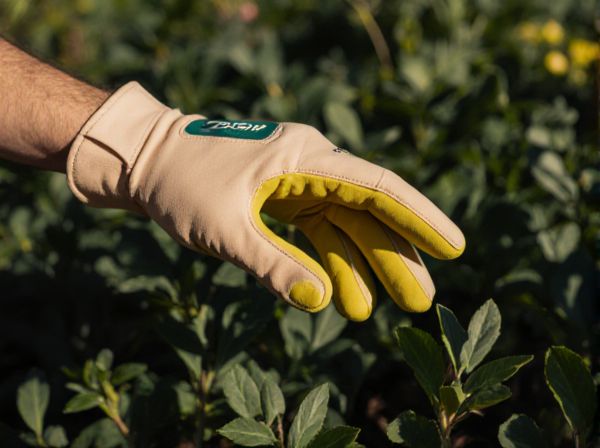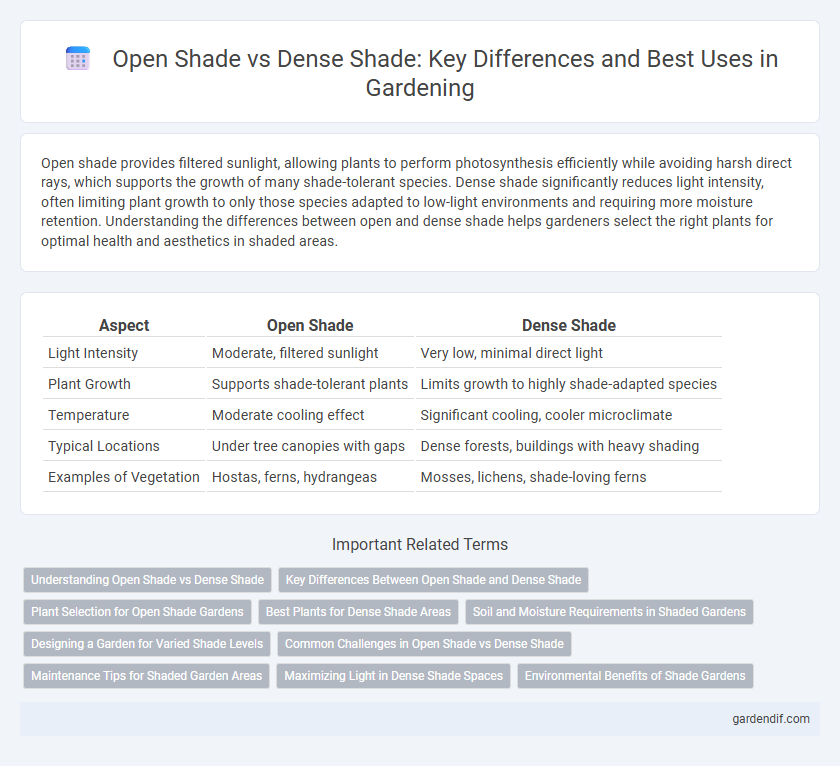
open shade vs dense shade Illustration
Open shade provides filtered sunlight, allowing plants to perform photosynthesis efficiently while avoiding harsh direct rays, which supports the growth of many shade-tolerant species. Dense shade significantly reduces light intensity, often limiting plant growth to only those species adapted to low-light environments and requiring more moisture retention. Understanding the differences between open and dense shade helps gardeners select the right plants for optimal health and aesthetics in shaded areas.
Table of Comparison
| Aspect | Open Shade | Dense Shade |
|---|---|---|
| Light Intensity | Moderate, filtered sunlight | Very low, minimal direct light |
| Plant Growth | Supports shade-tolerant plants | Limits growth to highly shade-adapted species |
| Temperature | Moderate cooling effect | Significant cooling, cooler microclimate |
| Typical Locations | Under tree canopies with gaps | Dense forests, buildings with heavy shading |
| Examples of Vegetation | Hostas, ferns, hydrangeas | Mosses, lichens, shade-loving ferns |
Understanding Open Shade vs Dense Shade
Open shade refers to areas receiving filtered or indirect sunlight through a sparse canopy, resulting in moderate light exposure ideal for shade-tolerant plants that require some sunlight for photosynthesis. Dense shade occurs under thick, continuous canopy layers where sunlight is minimal or absent, creating a cooler, low-light environment suited for plants adapted to deep shade conditions. Differentiating between open and dense shade is crucial for selecting the right vegetation and optimizing garden or landscape design based on light requirements and growth patterns.
Key Differences Between Open Shade and Dense Shade
Open shade allows filtered sunlight to reach plants, promoting moderate photosynthesis and growth, while dense shade significantly limits light, resulting in slower plant development. Open shade typically occurs under deciduous trees or structures with gaps, whereas dense shade is found beneath evergreen trees or dense canopies that block most light. Understanding these differences helps gardeners select shade-tolerant plants suited for specific light conditions, optimizing plant health and landscape design.
Plant Selection for Open Shade Gardens
Open shade gardens receive filtered sunlight, making them ideal for plants like hostas, astilbes, and ferns that thrive in dappled light conditions. Choosing species such as hellebores and coral bells ensures vibrant foliage and blooms without requiring full sun. These plants optimize growth in partial shade, enhancing garden biodiversity and aesthetic appeal.
Best Plants for Dense Shade Areas
Dense shade areas, characterized by minimal sunlight due to thick canopies, require plants with high shade tolerance and low light adaptability. Ideal plants for dense shade include hostas, ferns, and astilbes, which thrive with limited sun exposure and cooler soil temperatures. Selecting species such as Japanese forest grass and foamflower ensures vibrant foliage and seasonal blooms, enhancing the often challenging garden spots hidden under dense shade.
Soil and Moisture Requirements in Shaded Gardens
Open shade areas, characterized by filtered sunlight, generally support well-drained soils with moderate moisture retention, ideal for moisture-loving plants such as hostas and ferns. Dense shade zones, where sunlight is minimal, often require rich, organic soils that retain moisture without becoming waterlogged to sustain shade-tolerant species like ivy and certain mosses. Maintaining appropriate soil composition and moisture levels enhances plant health and growth in varying shaded garden environments.
Designing a Garden for Varied Shade Levels
Designing a garden for varied shade levels requires understanding the differences between open shade and dense shade to select appropriate plant species. Open shade, characterized by filtered sunlight with partial exposure, supports a wider range of shade-tolerant plants such as hostas and ferns, while dense shade, where sunlight is minimal or nearly absent, demands species adapted to low-light conditions like mosses and some varieties of ivy. Incorporating plants suited to these specific shade environments ensures healthy growth and a balanced, visually appealing garden.
Common Challenges in Open Shade vs Dense Shade
Open shade often results in uneven light distribution causing inconsistent plant growth, while dense shade limits photosynthesis due to minimal light penetration. Common challenges in open shade include managing fluctuating moisture levels and controlling weeds that thrive in partially lit areas. In dense shade, plants face stress from poor air circulation and increased humidity, leading to fungal diseases and stunted growth.
Maintenance Tips for Shaded Garden Areas
Open shade areas receive filtered sunlight, making them suitable for shade-tolerant plants that require moderate watering and periodic pruning to prevent overcrowding. Dense shade gardens often need soil enrichment with organic matter to improve nutrient availability and frequent mulching to retain moisture and suppress weeds. Regular inspection for pests and diseases is crucial in both environments to maintain plant health and encourage vigorous growth.
Maximizing Light in Dense Shade Spaces
Maximizing light in dense shade spaces involves selecting plants with high shade tolerance and reflective foliage to capture minimal available sunlight effectively. Utilizing light-colored mulch and reflective surfaces enhances natural light diffusion, improving overall brightness in dense shade environments. Strategic pruning of overstory branches can increase light penetration, supporting healthier plant growth in densely shaded areas.
Environmental Benefits of Shade Gardens
Shade gardens under open shade allow dappled sunlight, promoting biodiversity by supporting shade-tolerant plants and beneficial insects, which enhances ecosystem resilience. Dense shade reduces soil moisture evaporation and lowers ground temperature, contributing to energy conservation by minimizing the need for artificial cooling. Both types improve air quality by filtering pollutants and stabilizing microclimates, creating healthier urban and residential environments.
open shade vs dense shade Infographic

 gardendif.com
gardendif.com